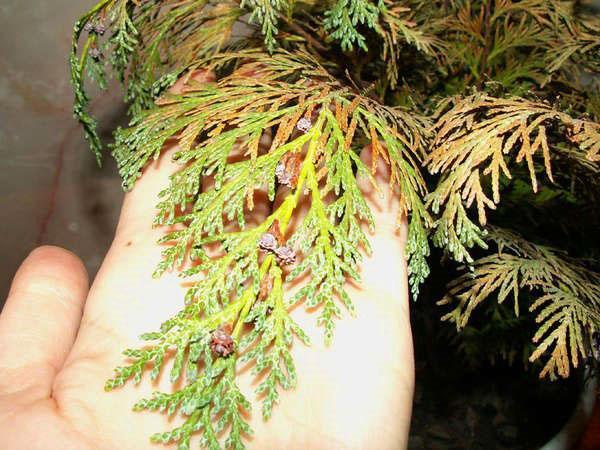Thuja diseases and frostbite
 Tui are used by landscape designers in the design of curb flower beds, as well as when planting hedge... Tui are conifers that need to be looked after. If curb varieties are planted on your site, then you do not need to water them. Instead of watering, regularly spray and irrigate conifers with warm water. If dwarf plants are not sprayed, the axils of branches and young shoots will clog with dust, and the thuja will turn yellow.
Tui are used by landscape designers in the design of curb flower beds, as well as when planting hedge... Tui are conifers that need to be looked after. If curb varieties are planted on your site, then you do not need to water them. Instead of watering, regularly spray and irrigate conifers with warm water. If dwarf plants are not sprayed, the axils of branches and young shoots will clog with dust, and the thuja will turn yellow.
Thuja forms new green shoots every year, they cover the old needles. Over time, the old branches of the tree turn yellow and then fall off. In some varieties, old branches turn red and crumble, mulching the soil. If you notice that the inner needles have begun to fall off, and the young shoots look green, then the thuja is healthy. But if the young growths began to turn yellow, then the tree is either affected by fungal diseases, or the thuja suffered from frost.
Treatment for fungal diseases
To cope with the consequences of fungal diseases, thuja must be treated with fungicides. When affected by fungal diseases, the branches of the tree turn brown or turn black. White bloom appears on the thuja needles. If the branch is too affected by fungal diseases, then it is pruned using a saw or garden shears. If the fungal spores have not yet spread along the branch, you can not cut it off, but simply treat it with a fungicide. The fungicide Tiovit Jet is often used. If the tree is badly damaged by the fungus, growth stimulants, for example, "Kornevin", are added to the fungicide solution. This formulation will ensure the rapid growth of new green shoots.
It is important not to confuse the defeat of fungal diseases with frostbite of thuja. With frostbite, the branches turn brown, there is no plaque on them. There will be frosts on the trunk of the thuja - large cracks on the bark. They must be covered with clay or garden pitch.
Pruning after frostbite
Frozen branches must be removed. Most often, the tip of the thuja suffers from frost. After removing the top and affected branches of the thuja, the tree will recover very quickly. After the formation of the crown, young shoots will grow, and after 2 years the thuja will regain its original appearance. To prevent the tree from suffering from frost, it must be planted near the fence or wall of the house. This will provide the plant with protection from the cold wind.